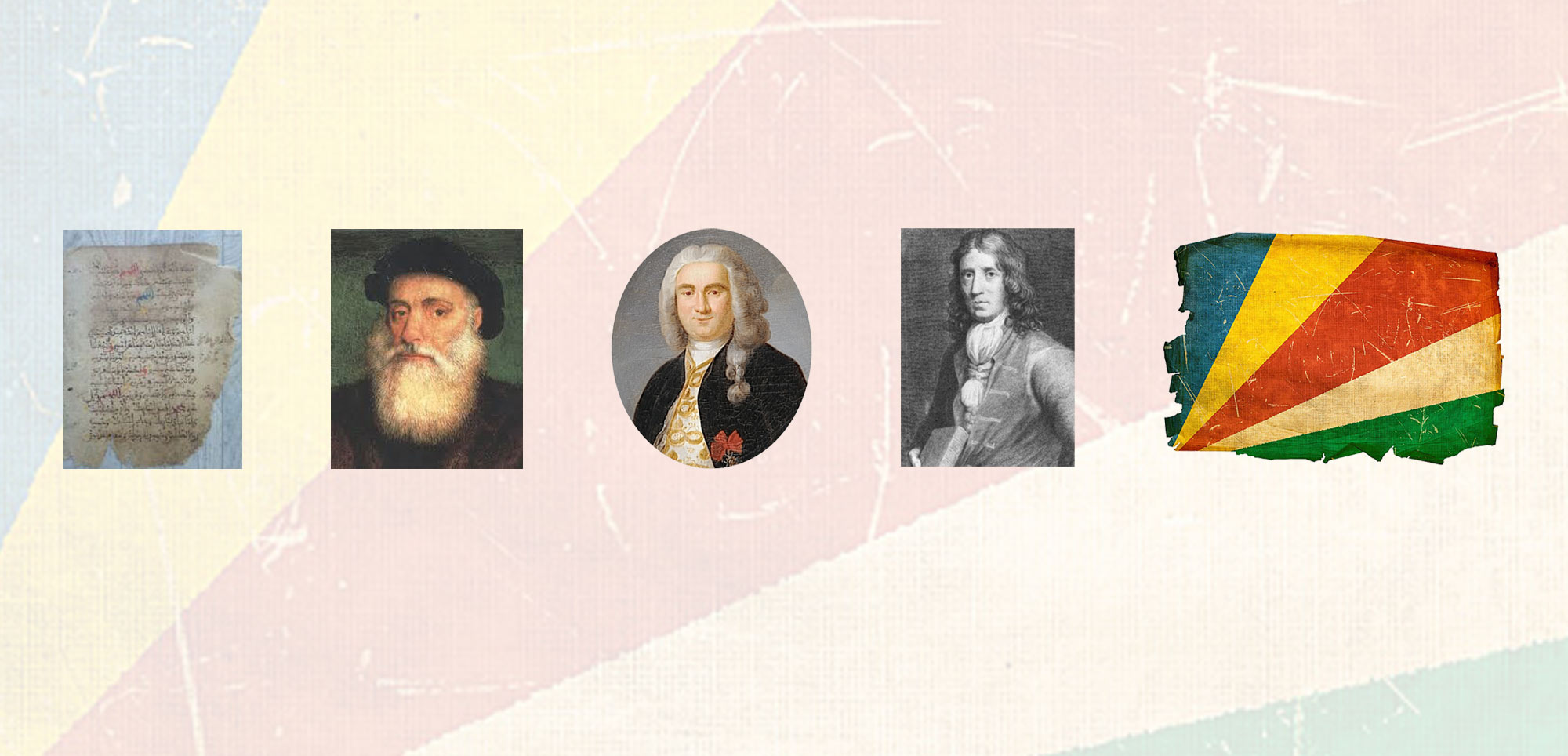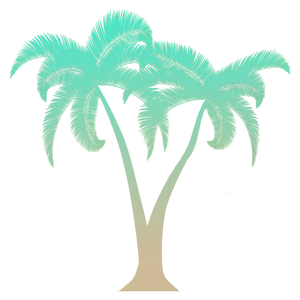HISTORY OF THE SEYCHELLES

Ganz alte arabische Dokumente erwähnen schon um 850 n. Chr. die Seychellen. 3 Männer allerdings sind bedeutend für die tatsächliche Entdeckung der Seychellen. Vasco da Gama, der geschichtlich wohl der erste war der um 1502 die Seychellen erblickte. Um ca. 1740 sendete Bertrand François Mahé de La Bourdonnais, die Flotte bestehend aus den Schiffen Elisabeth und Charles in die indischen Gewässer. Mit an Bord war der Kapitän Lazare Picault, der schlussendlich am 21. November 1742, die Seychellen entdeckte, indem er auf der von ihm benannten Insel L’Île d’Abondance ankerte um nach Trinkwasser zu suchen. Die Insel Mahé wurde später nach Bertrand François Mahé de La Bourdonnais umbenannt. Dies erfolgte im Jahr 1744 durch Lazare Picault, der damit seiner Dankbarkeit Ausdruck verleihen wollte.
In an Arabic document the "high islands" are mentioned, which are supposed to be on the other side of the Maldives
The first cards showing the so-called "sisters" - the Seychelles - appear
Vasco da Gama sighted the outer islands of the Seychelles on the way to India.
The British East India Company lands on Mahé with the ship Ascension.
The occupation by the French, The French captain Lazare Picault discovers the Seychelles for the French and French planters and their African slaves settle in the Seychelles
Lazare Picault names the main island of the Seychelles as Mahé
France expresses claims to the island of Mahé and names the Seychelles in honour of Jean Moreau de Séchelles at.
27 August 1770. Captain Leblanc Lecore brings the first colonists to the Seychelles in his ship, the Thélemaque, consisting of 15 white men, eight Africans and five Indians. The French settle on St Anne.
In today's Victoria on Mahé a small French garrison is established, which is taken over by the inhabitants of the Seychelles around 1790
The British frigate Orpheus, under the command of Captain Henry Newcome, arrived in Mahé on 16 May 1794.
After the Napoleonic wars, the sovereignty over the Seychelles passes to the British, who administer the archipelago from Mauritius
The Seychelles as a British colony, the Seychelles officially become a British colony. They have almost 8000 inhabitants, who are relatively wealthy due to the trade in cotton. Later, due to the falling cotton prices, coconut plantations are established
The history of slavery is officially abolished in the Seychelles
The settlement L'Etablissement - so called by the French - is renamed Victoria
A mudslide claims 70 lives in Victoria
The Seychelles have about 19,000 inhabitants. The main cultivated product is vanilla, furthermore trade is done with copra and cloves
The Seychelles will become an independent crown colony under Governor Sweet-Escott
During the First World War, the population of the Seychelles is undernourished due to the poor supply and economic situation
The islands are supplied with electricity and telephone connections
The political awareness of the population is growing. So they join together in groups such as the League of Coloured People and the Taxpayers' Organisation
In the history of the Second World War, the islands were used to refuel warships
A representation of the people is introduced
The Seychelles People's United Party (SPUP) of France Albert René and the Seychelles Democratic Party (SDP) of Sir James Mancham are founded. The Seychelles independence movement begins. The SPUP with a socialist orientation raises its first call for early independence. The SDP on the other hand advocates closer ties with Great Britain
Universal suffrage is introduced
The constitution is reformed. This sets the course towards independence
The international airport of Mahé is completed and officially opened on March 20, 1972 by Her Majesty Queen Elizabeth II, thus laying the foundation for the prosperity of those working in the tourism industry.
Seychelles retains internal autonomy
Seychelles is granted independence by Britain on 29 June 1976. Under British pressure, a grand coalition is formed. Under a presidential system, Mancham (SDP) becomes President and René (SPUP) Prime Minister.
The Seychelles as a one-party state, On June 5, a coup initiated by René leads to the fall of the strictly pro-Western Mancham. Under the new president René, the republic becomes a socialist one-party state based on the Tanzanian model
The SPUP is renamed the Seychelles People's Progressive Front (SPPF) and transformed into a socialist unity party
The system of the one-party state is laid down in a new constitution
A coup attempt by cloaked mercenaries fails
Tanzanian troops quell an uprising within the military
Albert René's second term of office begins. In the same year, the Seychelles, Mauritius and Madagascar join together to form the Indian Ocean Commission (IOC) together. In the IOC, regulations are made to promote trade, tourism and fisheries
Seychelles was still a one-party state where the SPPF was the only party allowed. All candidates had to be candidates of the party. Therefore, there was no real victory for Albert Rene in this election, as he was the only candidate. Albert Rene nevertheless entered his third term. A gradual liberalization begins
The return to the multi-party system, with district elections in December, shows the loss of confidence in the SPPF. The party congress decides to restore the multi-party system.
In June, the third Seychelles Constitution comes into force. The National Assembly is expanded to 34 members. Albert René is again the winner of the July elections. Thus his fourth term of office begins.
A constitutional amendment will regulate the succession of President Albert René. The office of Vice-President is created, to be taken over by James Michel, who was previously Minister of Finance, Defence and Communications
Seychelles joins the Southern African Development Community (SADC)
The SPPF wins the elections by an overwhelming majority and receives 30 of the total. 34 seats in parliament. The fifth term of office of Albert René begins. He is re-elected with 67% of votes
Seychelles joins the Indian Ocean Rim Association for Regional Co-operation (IORARC)
Albert René wins the early presidential elections in September with only 54% of votes left. His rival candidate Ramkalawan receives 45%.
The SPPF wins the parliamentary elections in December. It receives 54% of the votes and 23 of the total. 34 seats in parliament. The opposition party receives 43% and 11 seats
On 14 April 2004, James Alix Michel took over the office of President prematurely, previously held by Albert René, who resigned for health reasons in March 2004. James Michel is thus the 3rd President of the Seychelles
The severe tsunami of December 2004 also reached the Seychelles and caused great damage. There were no fatalities
The People's Progressive Front, which has been in power for 30 years, is elected for another five years with 54%. James Michel remains president. The opposition party, the Seychelles National Party led by the Anglican priest Wavel Ramkalawan, achieves 46 percent
Seychelles rejoins the SADC regional community
The Seychelles Rupee is freely convertible since September 2008. All payments in the Seychelles can therefore be made in this currency. The state has been considered insolvent since mid-2008. Within the framework of Operation Atalanta to secure sea routes against pirates operating mainly from Somalia, the EU supports the Seychelles in building up its own coastal protection
In the Gulf of Aden, international patrols have increased, so that pirates have placed their activities off the Seychelles. The warships of Operation Atalanta are now to operate as far as the Seychelles. This is necessary because the pirates are moving further and further away from the coastal waters, it is said
The Seychelles open their own university. Previously, students had to go overseas for higher education. Many stayed there. With its own university, the island state hopes to stop the "brain drain". The Unisey - as the new university is called - works in cooperation with the University of London, the Sorbonne in Paris and institutes from India and Australia to offer a wide range of studies
In the elections, 66-year-old James Michel wins against three competitors. It is his second term in office. The elections were fair. James Michel promises to further improve the economic situation and strengthen good governance in his second term of office
In May, the Seychelles East Africa System (SEAS) cable, which connects the island archipelago to the global fibre optic data network, reached the Seychelles on the west coast in Beau Vallon. This project by the government and two local telephone companies will significantly stimulate the service sector, but also the other sectors of the Seychelles economy: Internet availability will increase while costs will fall compared to the current satellite-based system
As part of the modernisation course, the government is focusing on renewable energies: This year, wind turbines are to supply the first electricity. The island of Silhouette is added to the UNESCO tentative list of sites suitable for possible World Heritage status
In the presidential election in December 2015, President James Michel ran for re-election, but failed to achieve an absolute majority in the first round of voting. He narrowly won the subsequent runoff election against Ramkalawan with 50.15 percent of the valid votes.
The economy has recovered and Seychelles has the highest per capita income of all African countries (as of 2016). On May 18th 2016 the Parliament of the Seychelles voted for an end to the criminalisation of homosexual acts by men, thus lifting the ban on same-sex love. On 27th September 2016, after the praise of the new Parliament in the morning, in which the opposition has the majority for the first time, President James Michel resigned with effect from 16th October. He was succeeded in office by his party colleague Danny Faure, who was previously Vice-President. Danny Antoine Rollen Faure is the 4th President of the Republic of Seychelles since 16 October 2016.
James Mancham, the first President of the Seychelles, died in the Seychelles on 8 January 2017 at the age of 77. In the 2017 press freedom ranking published by Reporters Without Borders, Seychelles ranks 87th out of 180 countries. The population of Seychelles on 31 December 2017 was 95,821
In May 2018, the annual inflation rate was 3.59% compared to 3.18% in May 2017. The party - Party Lepep renames itself United Seychelles
France-Albert René, the second President of the Seychelles, died in the Seychelles at the age of 83 on 27 February 2019.
The gross domestic product (nominal) in 2019 was approximately USD 1.65 billion or slightly more than USD 17,127 per capita, putting Seychelles in 53rd place worldwide and first out of 54 countries in Africa. GDP growth in 2019 was 3,57%.
The corona virus (COVID-19) has so far left only a few traces in the Seychelles. By July 2020 there were only 118 infections, no deaths.
Wavel Ramkalawan (59) is the new President of the Seychelles. With an electoral quota of 54.9%, 35,562 voters voted for him in the first round of voting. The former opposition party LDS now forms the government and provides the president. 25 seats are represented in parliament by the LDS and 10 seats by the United Seychelles.
Historie Stand: 25. April 2024
The latest results from the blog
